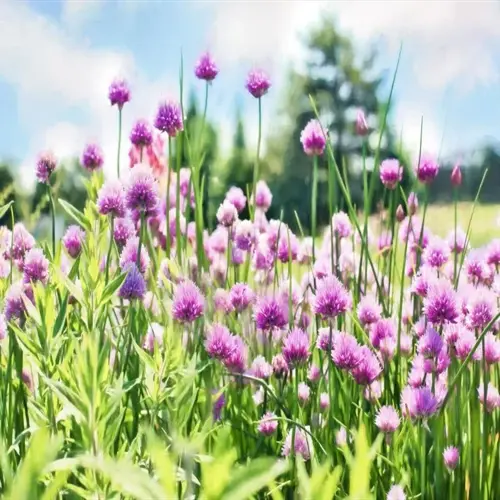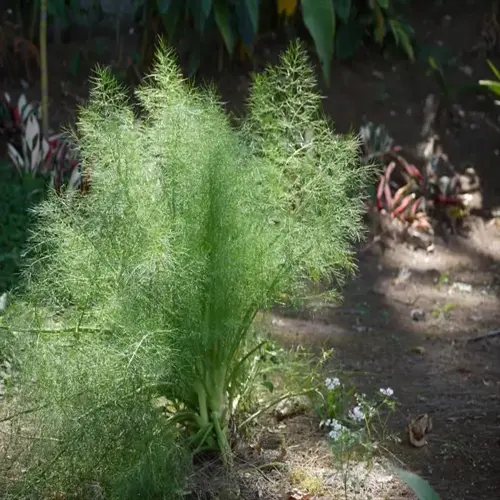How to Grow Fennel Successfully at Home

Written by
Julia Anderson
Reviewed by
Prof. Samuel Fitzgerald, Ph.D.Find out how to successfully grow fennel by obtaining 'bolt resistant' varieties such as 'Orazio'.
Create a well-draining soil mix of 40% compost, 40% topsoil, and 20% perlite.
Water consistently at 1 inch per week, increase to 1.5 inches when temperatures exceed 80°F.
Harvest bulbs at 3-4 inch diameter and the leaves at 12 inches tall.
Avoid bolting by using shade cloth when temperatures are above 75°F.
Store seeds in airtight containers with a silica gel pack to keep humidity below 10%.
Article Navigation
Learning to grow fennel is an incredibly versatile plant to pick for your kitchen and garden. A native of the Mediterranean region, it produces feathery foliage for ornamental purposes, crunchy bulbs for your culinary use, and fragrant seeds for cooking or planting. I have been growing fennel for a long time and admire it for its use in my landscape.
Fennel surprises new gardeners with its natural resistance/ injury to pests and tolerance to drought. This quality helps it thrive in a busy lifestyle. Fennel is expected to have fewer pest and disease issues compared to other herbs. The adaptability of is deeply rooted in three thousand years of cultivation.
My first fennel patch educated me that its Mediterranean origins demand well-drained soil. To be successful, you will need to recreate those conditions. In this article, I will share simple methods that have been proven effective, based on scientific research, for beginners like you. Overall, ensuring proper planting depth and optimal sunlight conditions are crucial factors for growing fennel successfully.
Troubleshooting Common Issues
Bolting is the primary issue with fennel. If they get above 75 °F (24 ºC), you will see premature flower stalks. You can install 30% shade cloth during very hot afternoons. Maintain soil moisture as needed with drip irrigation, which should deliver at least 1 inch (2.5 cm) of water weekly. If flowering occurs, harvest immediately.
Root rot often presents as soft, brown bulbs with a foul odor, particularly after heavy rainstorms exceeding 2 inches (5 cm) in depth. For drainage issues, use raised beds with a 40% compost mix. Plant bulbs a little above soil level. Remove affected plants and amend the soil with 20% perlite by volume.
For pest control, aphids will gather under leaves, and parsleyworms will eat the leaves. Use neem oil solution (1 tablespoon per quart) every three days. Hand-picking caterpillars should only be done if they feed on more than 20% of the crop. Consider planting dill 3 feet (90 cm) away and use it as a trap crop.
Nutrient deficiency is characterized by yellow leaves with green veins on older growth. Apply fish emulsion fertilizer diluted to half rate weekly, for three weeks. Apply 2 ounces per gallon (60 ml per 4 liters). Mix aged manure for fall bed preparation.
Slug damage leaves lumpy holes and slivery trails with wet weather above 60°F (15.5°C). Construct a ring out of diatomaceous earth, 2 inches wide and at least 0.25 inches thick (5 cm x 0.6 cm). Make beer traps and bury them; empty them every day when an infestation occurs.
Bolting Prevention
- Identification: Premature flower stalk formation triggered by temperatures above 75°F (24°C) or inconsistent watering patterns during growth phases
- Prevention: Install 30% shade cloth during peak afternoon heat and maintain soil moisture with drip irrigation delivering 1 inch (2.5 cm) weekly minimum
- Emergency Response: Harvest immediately if bolting begins; bulbs remain edible but develop stronger licorice flavor when flowering starts
Root Rot Solutions
- Identification: Soft brown discoloration at bulb base with foul odor, typically in waterlogged soil or after heavy rainfall exceeding 2 inches (5 cm)
- Drainage Fix: Create raised beds with 40% compost mixture and position bulbs slightly above soil line to prevent water accumulation
- Recovery: Remove affected plants immediately and amend soil with perlite at 20% volume ratio to improve oxygen circulation
Pest Management
- Aphid Control: Spray undersides of leaves with neem oil solution (1 tablespoon per quart of water) every 3 days until infestation clears completely
- Parsleyworm Balance: Hand-remove caterpillars only if damage exceeds 20% foliage; otherwise tolerate as they transform into beneficial swallowtail butterflies
- Preventive Measures: Plant trap crops like dill 3 feet (90 cm) away and encourage ladybugs with yarrow borders
Nutrient Deficiency
- Identification: Yellowing leaves with green veins appearing first on older foliage, indicating nitrogen shortage during active growth phase
- Organic Correction: Apply fish emulsion fertilizer diluted to half strength (2 oz per gallon or 60 ml per 4 liters) weekly for 3 weeks
- Soil Amendment: Incorporate aged manure at 1 lb per square foot (0.5 kg per 0.1 m²) during fall bed preparation
Slug Damage
- Identification: Irregular holes in leaves and silvery slime trails visible in morning, especially during wet weather conditions above 60°F (15.5°C)
- Barrier Method: Surround plants with diatomaceous earth ring 2 inches (5 cm) wide and 0.25 inches (0.6 cm) thick
- Trapping: Bury containers filled with beer 1 inch (2.5 cm) deep near plants, emptying daily during peak infestation periods
Harvesting and Storing Fennel
Fennel leaves can be harvested once the plants are 12 inches (30 cm) tall. Cut only the outer fronds with a pair of sterilized scissors, leaving approximately 70% of the foliage intact. For a constant supply, harvest every 10-14 days, typically during the peak season, at a temperature of 60-75°F (15-24°C). Choose bright green fronds that are intact.
Bulb harvest time - tennis-ball size 3-4 inches (7.5-10 cm) diameter and firm white base. Cut bulbs at the soil line, leaving 2 inches (5 cm) of stem attached to the bulb. Harvest in the early morning at temperatures under 70°F (21°C) for premium crispness, especially if bolting occurs; harvest immediately.
Collect seeds when heads have turned light brown, about 120 days after planting. Hang stalks upside down in a dark, well-ventilated area at 60-70°F (15-21°C) for 2-3 weeks. Rub the dried umbels to release the seeds, and store them in airtight containers with a humidity level of less than 10%.
Store fresh leaves wrapped in damp paper towels inside perforated bags at 34-38°F (1-3°C). Bulbs last 14 days in crisper drawers at 90-95% humidity. Check weekly for soft spots indicating spoilage.
After blanching the sliced bulbs for 3 minutes, quickly freeze them at -4°F (-20°C) for flash freezing. Thinly slice the bulbs and dry them at 120°F (49°C) for 8 to 10 hours. Store frozen pieces for 8-10 months and dried fronds for 1-2 years in opaque, airtight containers.
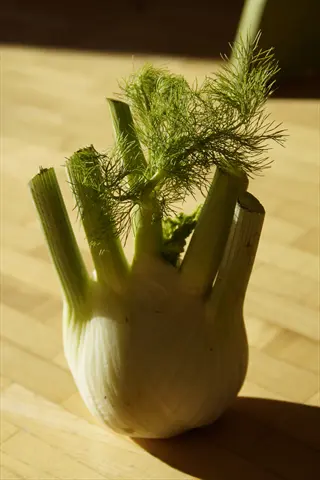
Leaf Harvesting
- Optimal Timing: Begin harvesting when plants reach 12 inches (30 cm) height, typically 60-70 days after planting during active growth phases
- Sustainable Method: Use sterilized scissors to cut outer leaves first, maintaining at least 70% foliage to ensure continuous regrowth
- Frequency: Harvest every 10-14 days during peak growing season between 60-75°F (15-24°C) temperatures
- Quality Check: Select vibrant green fronds without yellowing or insect damage for best flavor and aroma retention
- Post-Harvest Care: Immediately place stems in water to maintain turgor pressure until processing or culinary use
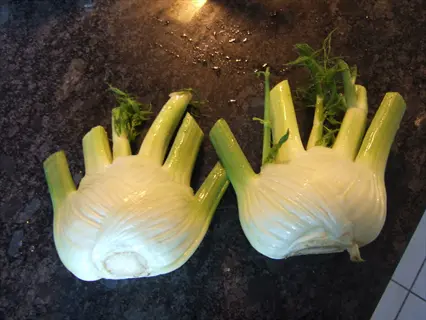
Bulb Harvesting
- Maturity Signs: Harvest when bulbs reach tennis-ball size (3-4 inches or 7.5-10 cm diameter) with firm white base before flowering occurs
- Cutting Technique: Use bypass pruners to sever bulb at soil line, leaving 2 inches (5 cm) of stem attached to prevent moisture loss
- Timing Window: Harvest in early morning when temperatures are below 70°F (21°C) to maximize crispness and sugar content
- Bolting Response: If flower stalk emerges, harvest immediately as bulbs become woody and develop stronger licorice notes
- Size Flexibility: Smaller bulbs (2 inches/5 cm) can be harvested early for tender texture in salads and quick-cooking dishes
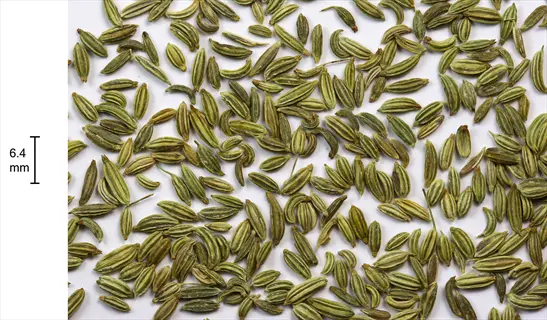
Seed Collection
- Readiness Indicators: Harvest seed heads when they turn light brown and develop papery texture approximately 120 days after planting
- Drying Process: Hang flower stalks upside down in dark, well-ventilated area at 60-70°F (15-21°C) for 2-3 weeks until completely dry
- Extraction Method: Rub dried umbels between palms over bowl to release seeds, then winnow to remove chaff using gentle airflow
- Storage Prep: Place seeds in airtight containers with silica gel packets to maintain below 10% humidity for maximum viability
- Viability Period: Properly stored seeds remain viable for 3-4 years, with germination rates decreasing by 15% annually after first year
Fresh Refrigeration
- Leaf Preservation: Wrap fronds in damp paper towels and store in perforated plastic bags at 34-38°F (1-3°C) for 7-10 days maximum freshness
- Bulb Technique: Place unwashed bulbs in crisper drawer at 90-95% humidity with ventilation slits open to prevent condensation buildup
- Duration: Maintain quality for 14 days; check weekly for soft spots or discoloration indicating deterioration
Freezing Preparation
- Blanching Process: Submerge sliced bulbs in boiling water for 3 minutes then immediately ice bath for equal time to preserve texture
- Flash Freezing: Arrange blanched pieces on parchment-lined trays at -4°F (-20°C) for 2 hours before bagging to prevent clumping
- Storage Life: Maintain optimal flavor and texture for 8-10 months at constant 0°F (-18°C) freezer temperatures
Dehydration Methods
- Oven Drying: Arrange thin bulb slices on racks at 120°F (49°C) for 8-10 hours with door slightly ajar for moisture escape
- Frond Processing: Hang bundles in dark, well-ventilated area below 90°F (32°C) for 5-7 days until crumbly texture develops
- Storage Containers: Use opaque airtight jars stored in cool pantry below 70°F (21°C) to preserve color and volatile oils for 1-2 years
Pickling Solutions
- Basic Brine: Combine equal parts water and vinegar with 1 tablespoon salt per cup (15g per 240ml) heated to 180°F (82°C)
- Processing: Pack sterilized jars with sliced fennel and spices, leaving 0.5 inch (1.25 cm) headspace before sealing tightly
- Shelf Life: Store unopened jars in cool dark place for 12 months; refrigerate after opening and consume within 4 weeks
Oil Infusion
- Herb Preparation: Thoroughly dry fronds for 48 hours at 60°F (15.5°C) before chopping to prevent bacterial growth in oil
- Infusion Technique: Combine with olive oil in sterilized bottles at 1:3 herb-to-oil ratio, stored at 50-60°F (10-15.5°C)
- Usage Window: Maintain quality for 3 months; discard if cloudiness or off-odors develop indicating spoilage
Planting and Care Essentials
Before planting, prepare the soil by mixing 40% compost, 40% topsoil, and 20% perlite for improved drainage. Test the pH, aiming for a range of 6.0-7.0, adjusting with lime if the pH is below 5.5 or sulfur if it is above 7.5. Build raised beds at least 12 inches (30 cm) deep.
After the last frost, plant seeds at a depth of 0.25 inches (0.6 cm) when soil temperature reaches 55°F (13°C). Bulbing types should be planted 12 inches (30 cm) apart, and leafy types should be planted 6 inches (15 cm) apart. Misting to keep the soil moist until the seedling emerges.
Water established plants with drip irrigation, delivering 1 inch (2.5 cm) of water weekly. Increase to 1.5 inches (3.8 cm) during temperatures above 80°F (27°C). Check moisture by feeling the top 1 inch (2.5 cm) of soil.
To protect plants from frost below 32°F (0°C), you can use floating row covers and remove them once the temperature is above 40°F (4 °C). You can use a 30% shade cloth when temperatures are above 85°F (29°C) and remain sustained for at least four hours. You want to maintain a range of 60 - 70 °F (15 - 21 °C) when possible.
For bulbing varieties mound soil around bulbs at 2 2-inch (5 cm) diameter, keeping the top exposed. For leaf types, pinch tips at 12 inches (30 cm) height to promote bushiness. Fertilize bulbing fennel with a balanced 5-5-5 NPK fertilizer.
Soil Preparation
- Composition Ratio: Mix 40% compost, 40% topsoil, 20% perlite for optimal drainage and fertility
- pH Adjustment: Maintain 6.0-7.0 pH using agricultural lime if below 5.5 or sulfur if above 7.5
- Bed Construction: Raised beds minimum 12 inches (30 cm) depth with 4 inches (10 cm) compost topping
Water Management
- Germination Phase: Mist soil surface daily until seedlings emerge (7-14 days)
- Established Plants: Drip irrigation delivering 1 inch (2.5 cm) weekly; increase to 1.5 inches (3.8 cm) when >80°F (27°C)
- Moisture Check: Water when top 1 inch (2.5 cm) of soil is dry; use finger test or moisture meter
Temperature Control
- Heat Protection: Install 30% shade cloth when air temperatures exceed 85°F (29°C) for >4 hours
- Frost Response: Cover plants with floating row covers when <32°F (0°C); remove when >40°F (4°C)
- Optimal Range: Maintain 60-70°F (15-21°C) using cloches or cold frames in early season
Variety-Specific Care
- Bulbing Fennel: Hill soil around bulbs when 2 inches (5 cm) diameter for blanching; maintain consistent moisture
- Leaf Fennel: Pinch tips at 12 inches (30 cm) height to encourage bushiness; harvest outer leaves first
- Seed Production: Stake plants at 24 inches (60 cm) height; isolate varieties by 100 feet (30 m) to prevent cross-pollination
Fertilization Schedule
- Transplant Boost: Apply ¼ cup balanced fertilizer (5-5-5 NPK) per plant at transplanting
- Mid-Season Feed: Side-dress with compost tea every 3 weeks during active growth phases
- Caution: Avoid high-nitrogen fertilizers which promote foliage over bulb development in bulbing varieties
Types of Fennel to Grow
Bulbing cultivars such as Orazio contain a subtly sweet anise flavor, which is delightful in salads eaten raw. Orazio plants are compact and reach heights of about 24 inches (60 cm). They yield a white bulb with crisp flesh. Orazio can grow well in zones 5-9, with an optimal growing temperature between 50-75°F (10-24°C). They are bolt-tolerant, so they can benefit someone new to the field, but they require consistent moisture.
Solaris bulbing fennel boasts robust licorice flavors, making it perfect for roasting. At 30 inches (75 cm) tall, it survives light frost to 28°F (-2°C). Rated for zones 4-8, the foliage requires afternoon shade over 85°F (29°C) to prevent premature flowering.
Bronze leaf fennel features purple-tinged foliage that can grow up to 36 inches (90 cm) tall, making it an ideal choice for ornamental gardens. Its flavor is laced with delicate notes and can be used in teas and as a garnish. It is best grown in zones 6-10 at temperatures ranging from 55°F to 80°F (13 °C to 27°C). For optimal leaf production, pinch off flower buds as they appear.
Sweet leaf fennel has a wonderful, concentrated aromatic oil that makes it very nice for herbal infusions. 30-inch (75 cm) bushy plants produce abundant foliage in zones 7-11, with temperatures ranging from 60-85°F (16-29 °C). Cutting regularly leads to growth, but be aware that aphids can pester it, and using neem oil sprays can be helpful.
Zefa Fino bulbing fennel has an attractive, crispy crunch and mild flavor. Compact plants reach 18 inches (45 cm) in height and thrive in small spaces, suitable for zones 5-8, with temperatures ranging from 50°F to 75°F (10-24°C). To avoid transplant shock, sow directly in deep, loose soil.
Orazio (Bulbing)
- Flavor Profile: Mild anise taste with crisp white bulbs reaching 4-5 inches (10-13 cm) diameter
- Growth Habit: Compact 24-inch (60 cm) height with bolt-resistant characteristics ideal for beginner growers
- Climate Suitability: Performs best in zones 5-9 with temperature range 50-75°F (10-24°C)
- Special Care: Requires consistent moisture and hilling when bulbs form to prevent greening
Solaris (Bulbing)
- Flavor Profile: Intense licorice notes with dense bulbs maturing faster at 70 days in cool climates
- Growth Habit: Taller 30-inch (75 cm) stalks tolerate light frosts down to 28°F (-2°C) when established
- Climate Suitability: Optimal for fall harvests in zones 4-8 with temperature range 45-70°F (7-21°C)
- Special Care: Benefits from afternoon shade in regions with summer temperatures above 85°F (29°C)
Bronze (Leaf)
- Flavor Profile: Delicate anise flavor with purple-tinged feathery foliage for ornamental displays
- Growth Habit: Reaches 36 inches (90 cm) with dark bronze leaves contrasting green garden backgrounds
- Climate Suitability: Thrives in zones 6-10 with temperature range 55-80°F (13-27°C)
- Special Care: Pinch flower buds to prolong leaf production; requires well-drained soil to prevent root rot
Sweet (Leaf)
- Flavor Profile: Strong aromatic oils ideal for teas, with sweeter notes than common fennel varieties
- Growth Habit: Bushy 30-inch (75 cm) plants producing abundant foliage from multiple harvests
- Climate Suitability: Best in zones 7-11 with temperature range 60-85°F (16-29°C)
- Special Care: Regular cutting promotes new growth; susceptible to aphids requiring neem oil prevention
Zefa Fino (Bulbing)
- Flavor Profile: Extra-crunchy texture with mild flavor, maturing in 80 days under optimal conditions
- Growth Habit: Uniform bulbs develop at soil line with 18-inch (45 cm) compact frond structure
- Climate Suitability: Bolt-resistant in zones 5-8 with temperature range 50-75°F (10-24°C)
- Special Care: Requires deep loose soil; sensitive to transplant shock necessitating direct sowing
5 Common Myths
Fennel grows best in full sun in every season without exception.
Fennel prefers full sunlight but will tolerate partial shade in hotter regions (zones 8-11) in summer. Fennel also benefits from afternoon shade in regions which see temperatures above 85°F (29C); this will prevent bolting and keep bulb quality. The plant needs a minimum of 6 hours of direct sunlight but benefits from protection when the heat is maximized in southern zones.
Fennel bulbs develop entirely under the ground like root vegetables such as carrots or potatoes.
Bulbs develop above the soil line, and the stem base expands, which requires carefully hilled soil for blanching. If the developing bulb is submerged completely all the way to the crown, the bulb collar may rot because of the moisture. In commercial production, growers hilled soil around the developing bulbs, but never hilled completely so that the top third of the bulb was exposed to sunlight, allowed for good air circulation around the developing pointed bulb, and to prevent fungal disease in humid growing conditions.
Transplanting fennel seedlings always results in failure due to root disturbance issues.
Successful transplanting requires biodegradable pots that decompose without root disruption. When moving seedlings, maintain intact root balls and plant at original soil depth within 60-75F (16-24C) temperatures. Hardened-off transplants show 90% survival rates when handled gently and watered with seaweed extract solution to reduce shock.
Chemical pesticides must be applied routinely to control common pests infesting fennel plants in home gardens.
Fennel naturally repels most pests through its aromatic oils, with aphids being the primary exception. Introducing ladybugs and planting trap crops like dill reduces infestations by 85%. Weekly neem oil applications (1 tbsp per quart) effectively control outbreaks without chemicals, preserving beneficial pollinators like swallowtail butterflies that use fennel as host plants.
All fennel varieties bolt quickly when temperatures rise slightly above optimal range.
Bolt-resistant cultivars like Orazio and Solaris withstand temperatures up to 80°F (27C) without premature flowering. Bolting occurs mainly due to temperature fluctuations exceeding 15°F (8C) daily swings or inconsistent watering. Maintaining soil moisture and providing afternoon shade prevents bolting even during summer heatwaves in zones 5-9.
Conclusion
Gaining competence in how to grow fennel is based upon three essential tenets. Amend the soil to ensure proper drainage by incorporating 40% compost. Water regularly using drip irrigation to supply 1 inch (2.5 cm) of water every week. Harvest when the bulb is 3-4 inches (7.5-10 cm) wide, or the leaves are 12 inches (30 cm) long.
For beginners, I recommend Orazio bulbing fennel for its resistance to bolting. This variety will be able to handle temperature changes better than other varieties. The compact shape makes it easier to take care of the plant in small plots and gardens. You will also be rewarded with consistently producing each harvest when your watering schedule changes a little while you are learning.
To sustain your plants, save seeds from your best plants. Collect brown seed heads and hang them upside down in a dark, dry place until they are completely dry. After two to three weeks, rub the dried umbels over a container to catch the seeds. Store your seeds in airtight jars with silica gel packs (keep below 10% humidity).
You can plant fennel seeds today with these proven methods. The best location is a sunny spot with well-draining soil. Your first harvest will not only provide you with fresh flavor in the kitchen - it will also be a thing of beauty in the garden. Most of all, you'll love knowing that you grew this wonderful herb for yourself!
External Sources
Frequently Asked Questions
What plants should not be grown near fennel?
Fennel inhibits growth of beans, tomatoes, and kohlrabi through allelopathic compounds. Plant it separately from vegetables sensitive to root competition. Instead, grow it with dill which attracts beneficial insects without cross-pollination issues.
Does fennel regrow after harvesting?
Leaf varieties regenerate when harvested correctly. Cut outer leaves at the base while leaving the central growth point intact. This allows multiple harvests throughout the growing season. Bulbing types don't regrow after bulb harvest.
Can fennel grow successfully in containers?
Choose compact varieties like Zefa Fino. Use deep pots with drainage holes and quality potting mix. Ensure containers receive at least six hours of direct sunlight daily. Water more frequently than garden plants.
What pests commonly affect fennel plants?
Aphids target young growth while swallowtail caterpillars eat foliage. Control them using organic methods:
- Spray neem oil solution weekly
- Introduce ladybugs as natural predators
- Use physical barriers like row covers
How do you prepare fennel for winter?
In cold climates, harvest bulbs before frost. For perennial varieties, mulch heavily with straw after cutting back foliage. Container plants should be moved indoors to a sunny location before temperatures drop.
Why does fennel sometimes fail to form bulbs?
Bulb development requires specific conditions: consistent moisture, cool temperatures, and adequate spacing. Bolting due to heat or root disturbance also prevents proper bulb formation. Choose bolt-resistant varieties.
Can fennel be grown indoors year-round?
Leaf varieties thrive indoors with sufficient light. Use full-spectrum grow lights for at least eight hours daily. Maintain temperatures between 60-75°F and ensure good air circulation to prevent disease.
What are the health benefits of fennel?
Fennel offers digestive support and contains antioxidants. Both bulbs and seeds provide dietary fiber and essential nutrients. However, consult a doctor before using medicinally, especially during pregnancy.
How do you harvest fennel seeds?
Collect seeds when flower heads turn brown. Cut stems and hang upside down in a dry, dark place. After drying, rub heads over a container to release seeds. Store in airtight containers.
Why soak fennel before cooking?
Soaking in ice water crisps the bulbs and reduces bitterness. This technique enhances texture for raw preparations. For cooked dishes, soaking isn't necessary but improves mouthfeel in salads.
